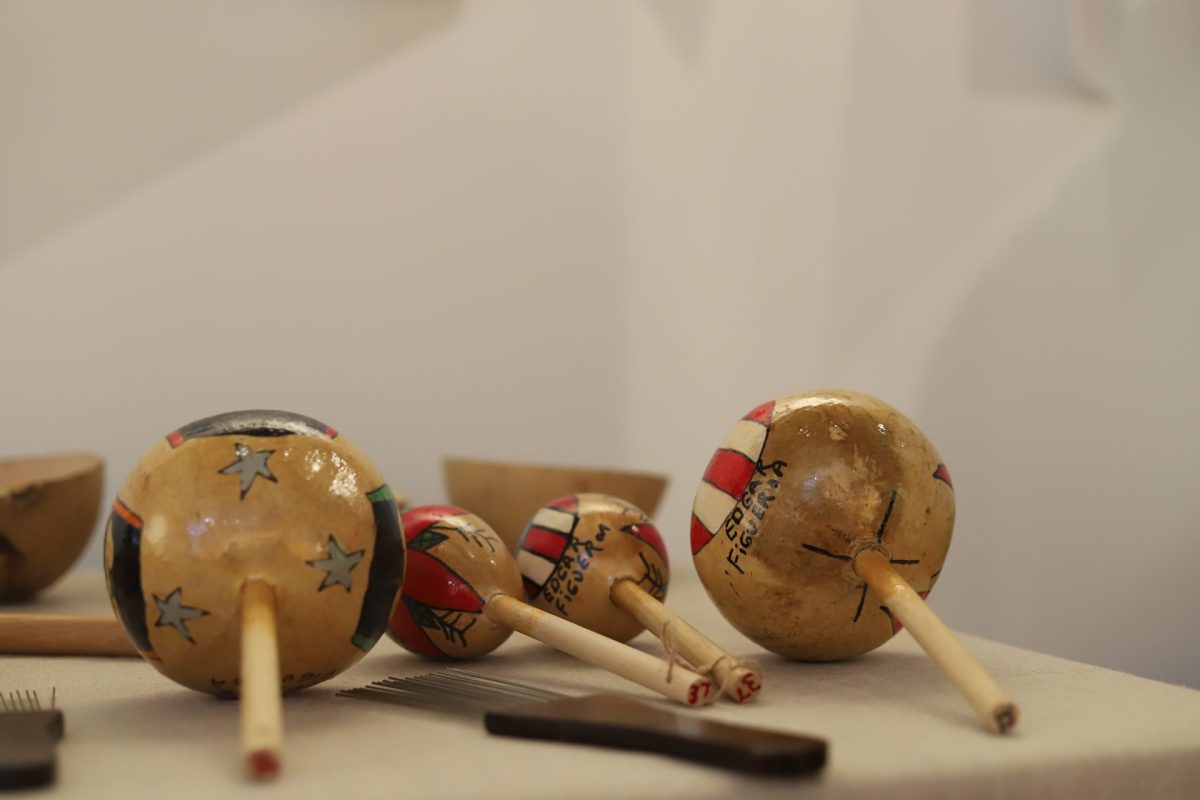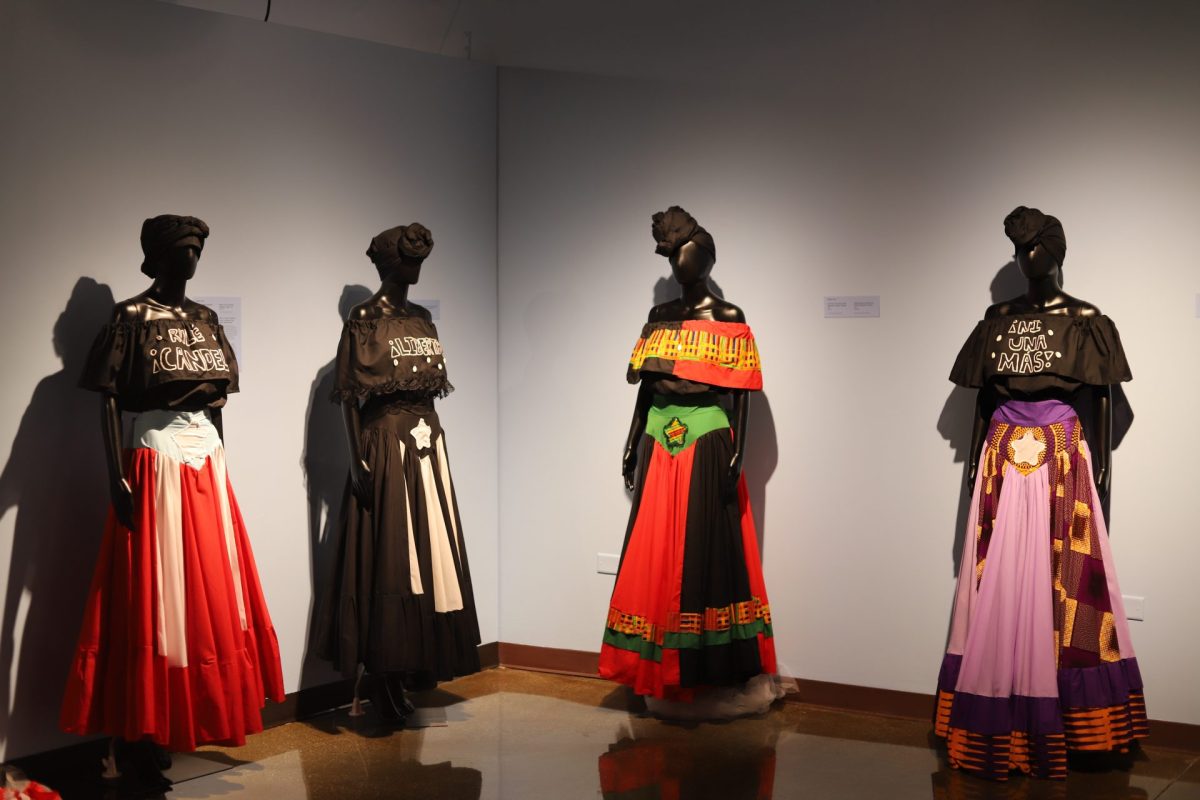Chicago’s National Museum for Puerto Rican Arts and Culture is home to some of the city’s most niche, yet revolutionary history and art.
For Chicago’s culturally syncretic Afro-Latine community, the museum is currently offering two unique exhibits.
Milteri Tucker Concepcion, a bomba dance instructor and a skirt maker, curated one of the exhibits. She added a gallery of hand-sewn and colorful bomba skirts titled ‘Resistencia y Libertad,’ which can be translated to resistance and freedom.
Concepcion’s bomba skirt exhibit is an example of how museum spaces can be healing because it highlights the pride and tenacity of African-Indigenous presence in Puerto Rican culture, said Veronica Ocasio, who works alongside her husband, Billy Ocasio, the CEO of the museum.
“Museums are places to educate, engage and celebrate,” Veronica Ocasio said. “They are a safe space to have hard discussions, heal and understand.”
With the new exhibits, they intend to uplift the voices of indigenous Afro-Latines in the city and educate others about them.
The bomba skirt gallery reflects the legacy of Afro-Indigenous tribes such as the Taino, who are a blending of African and Indigenous enslaved people in the Greater Antilles.
Another exhibit narrates the history of music and dance within the Taino tribes from the Greater Antilles. It is titled ‘Taino Vive!.’

The Ocasio’s collaborated with the Smithsonian Institution, who provided much of the history of the exhibit. It has calabash maracas and various spiritual figurines beloved by the Taino, demonstrating that the tribe is not extinct, and its legacy survives in today’s Afro-Latine art.
Percussive instruments were a staple in Afro-Latine rhythm that survived from colonialism, said Symone Johnson, a DePaul professor of African Diaspora studies. She calls the practice, “expressive culture.” She said the culture was passed along through generations of African-Indigenous blending. It includes any practice related to language, music, dance and art which helps express feelings and thoughts.
“We convey our stories through expressive cultures like music and dance,” Johnson said. “These are forms of storytelling, and I think storytelling is really effective in preserving our cultural history.”
Now that the Taino people are re-establishing their presence in cities like Chicago, other Afro-Latines are doing the same.
Del Dominguez, owner of salsa dance studio Mayambo Dance Company in Humboldt Park, promotes Afro-Latine inclusion by teaching about salsa’s Afro-Cuban roots.
Dancers like Concepcion and Dominguez have an appreciation for Afro-inspired dances such as bomba and salsa despite their European influence.
Bomba dance stems from Afro-Puerto Rican communities and is unique in that its drummers improvise their rhythm based on how dancers move. The dancers wear puffy sleeves and draped skirts along with head wraps.
For Concepcion, hand-crafting bomba skirts is more than a profession, but rather, an active statement of resistance against white supremacy. Inside her gallery, a tall bomba queen surveys the room in a red and white skirt representative of the Puerto Rican flag. Concepcion purposely chose a Black mannequin with a curly wig to encapsulate the presence of African roots, she said.
“It’s important that dance and fashion go hand in hand,” Concepcion said. “The attire defines a time and mood.”
Dominguez incorporates spirituality and energy into his salsa classes to express his Afro-identity.
Salsa originates from Cuba and is rooted in Mambo dance, a descendant of the African Danzon dance. Dominguez mirrors the characteristics of Yoruban spirits into his dances. They include Elegua, a playful boy, the water spirit Yemaya and Shango, a royal.
“When you do Yemaya, you have to be wavy and when you do Shango, you have to be masculine and pull all these different energies out of you,” Dominguez said.
For both Concepcion and Dominguez, advertising their dance communities and classes serve as a way to preserve indigenous identity building through music.
Many people have lost the connection to their ancestral roots, they said.
“It’s unfortunate that many Black dancers don’t realize what connection they have to what we’re doing,” Dominguez said. “You are culturally part of this, you’re just not aware because it’s not been made available to you.”
That is why the Ocasios are devoted to offering accessible pathways to rediscover the culture at the museum.
Billy Ocasio said that younger people, or other people from communities of color may feel unwelcome at Chicago’s downtown museums because they appear more exclusive and are often barricaded with their glass enclosures. There’s also predominantly white staff.
“It starts with who makes up your staff and board. It has to be inclusive and diverse, and from there, you start exploring,” he said.
Concepcion said that she likes to collaborate with the museum because it offers fresh angles on preserving and embracing Afro-Indigenous history in a world where many Afro-Latines face colorism within their own Hispanic community.
Though small, the Taino tribe carries its decolonial power through dancers such as Concepcion and Dominguez, who said they aim to dismantle white-washed history through their continued social activism and inclusion of Afro-Latine culture.
“When I dance bomba, I feel free and forget about the world,” Concepcion said. “It’s a form of educating our Hispanic-Latino community that the Afros are there. We’ve been there, fighting alongside our indigenous brothers and sisters for freedom.”
Cover Photo: Mannequins of Milteri Tucker Concepcion’s bomba wear exhibit in the National Museum of Puerto Rican Art dressed in handmade bomba outfits. Concepcion used different patterns and colors to convey different social justice issues in Puerto Rico. (Photo Credit: Emily DIaz)
Publisher’s Notes: “Afro-Latines in Chicago Carry on Indigenous Roots through music and fashion” was first published on The DePaulia. To read the story in Spanish, click HERE.
Illinois Latino News (ILLN) and La DePaulia are partners in best serving the Hispanic-Latino community.
